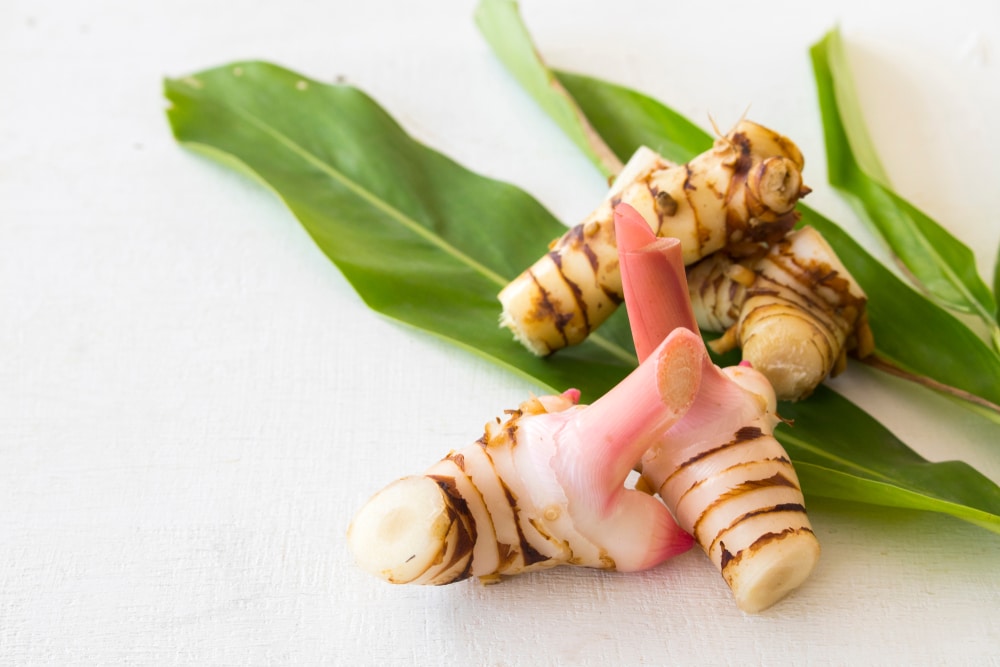
Galangal is a well-known addition to South Asian cuisines, and it is basically a strong spice and has unique flavors, which can be challenging to replace. However, beginners have a hard time using fresh galangal, which is why using galangal paste is recommended. The paste has a piney, citrusy, and bright flavor – it is pretty pungent and leaves behind a ginger-like flavor to the recipe. The galangal paste can be challenging to find, which brings us to galangal paste substitutes!
Galangal Paste Substitutes
- Ginger
Ginger is one of the most delicious spices out there and is regularly used as folk medicine in Asian countries. It belongs to the same family as galangal, which is why it has a similar flavor. The fresh ginger has mild sweetness as well as a robust aroma. If you want to replace galangal paste, you can opt for ginger paste. It can be used to marinate meat or fish, or you can use it to flavor soups, stir-fries, and stews. However, you need to remember that ginger paste doesn’t have citrusy flavor notes, which is why it’s recommended that you add some lemon zest or lemongrass to the paste. In fact, you can also mix some lemon juice.
- Fingerroot
Commonly known as Chinese ginger, fingerroot has a finger-like appearance with a brownish and orange hue. It has a mild aroma, which makes it suitable to replace galangal paste in seafood recipes. In addition, it can be added to Cambodian and Thai cuisines to cover the pungent fishy flavor. It has a similar flavor to galangal paste, but it’s recommended that you opt for a ¾ substitution ratio and gradually increase it according to the desired flavor.
- Lemongrass
Lemongrass is widely used to make detox tea, but you can also use it to replace galangal paste in the recipes. It can be used to replace galangal paste in Asian and Vietnamese cuisines, especially stir-fries, soups, dips, and stews. Just like galangal paste, lemongrass also has spiciness and pungency. In particular, it has an appealing aroma and adds a hint of hotness to the recipe.
- Kaffir Lime Leaves
The kaffir lime leaves are usually used in Thai cuisine and have become an important addition to Malaysian recipes. These leaves have a unique texture and can be used just like galangal paste. It has a very distinct flavor, which can be defined as spiced and citrusy. The leaves are edible, but it’s recommended that you chop them to release the flavor. As far as the usage is concerned, you can use them in stir-fries. On the other hand, if you want to use kaffir lime leaves as a substitute for galangal paste to remove the fishy smell, you will have to add more leaves. Also, they taste delicious in soups and curries.
- Turmeric
If you’ve been cooking for a long time, you would know about turmeric, and it actually works as a substitute for galangal paste. Turmeric adds a unique yellow tint to the dish, which makes it suitable for stews and curry. It can be used to replace galangal paste in Vietnamese, Indian, and Thai cuisines. As far as the flavor is concerned, turmeric has a bitter, earthy, sharp, and musky flavor with a bit of pepperiness. It’s recommended that you add it to curries and stews because its bitter flavor will be evident in pastes and stir-fries.
- Horseradish
Horseradish is one of the most amazing substitutes for galangal paste and belongs to the family of kale and broccoli. It is basically a condiment with a pungent aroma, and many people compare it with wasabi. It can be grated and added to sauces. In addition, it can be used to add a complementing flavor to beef, fish, and meat. What we love about horseradish is that it adds a pungent kick to the soups, but you must grate them to release the flavor and aroma. However, you should always add horseradish in the final stages of cooking.
- Galangal Powder
The last and most promising substitute for galangal paste is galangal powder, as it helps replicate the flavor. It is easy to find in grocery stores and has a longer shelf life, which makes it easy to store. However, you need to remember that galangal powder has a sharp aroma but less spiciness.